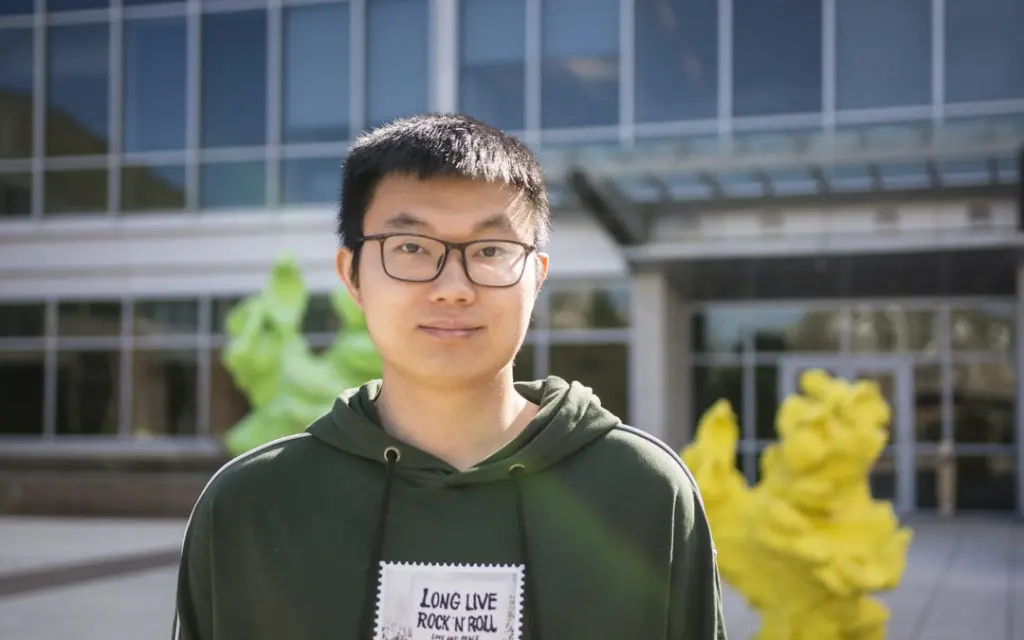Researchers have identified key ingredients for producing high-value chemical compounds in an environmentally friendly fashion: repurposed enzymes, curiosity, and a little bit of light.

A paper published in Nature describes a study led by Xiaoqiang Huang (pictured), a postdoctoral researcher in the University of Illinois at Urbana-Champaign’s Department of Chemical and Biomolecular Engineering (ChBE) and the Carl R. Woese Institute for Genomic Biology (IGB). Huang works in the lab of ChBE Professor Huimin Zhao, Conversion Theme Leader at the Center for Advanced Bioenergy and Bioproducts Innovation (CABBI), a U.S. Department of Energy-funded Bioenergy Research Center (BRC).
Catalysts are substances used to speed up chemical reactions; in living organisms, protein molecules called enzymes catalyze reactions in a process called biocatalysis.
Biocatalysis is rapidly emerging as a nuanced, agile way to synthesize valuable compounds. Scientists are investigating the ability of enzymes to catalyze diverse reactions, and for good reason: biocatalytic reactions are highly selective, meaning that scientists can use enzymes to act on specific substrates and create target products.
Enzymatic reactions are also highly sustainable as they are relatively inexpensive, consume low levels of energy, and do minimal damage to the environment: while chemical catalysts typically require organic solvents, heat, and high pressure to function, biocatalysts work in aqueous solutions, operating at room-temperature and normal-pressure conditions.
Despite their value to science and sustainability, enzymes can be complicated to work with. Reactions enzymes can catalyze are limited to those found in nature; this means that scientists often struggle to track down the perfect biocatalyst to meet their need.
The process is similar to mixing paint: How can an artist creatively combine the colors already on a palette to produce the right shade? In the language of a chemical reaction: How can scientists leverage enzymes already existing in nature to create the products they need?
The research team developed a solution: a visible-light-induced reaction that uses the enzyme family ene-reductase (ER) as a biocatalyst and can produce high yields of valuable chiral carbonyl compounds.
“Our solution might be considered ‘repurposing.’ We take known enzymes that occur in nature, and repurpose them for a novel reaction,” Zhao said.
In other words, the researchers didn’t need to add a new kind of paint to the palette — they discovered an artful way to combine what was already there.
These “repurposed” enzymatic reactions are not only economically and environmentally efficient, but highly desirable: chiral carbonyl compounds have potential applications in the pharmaceutical industry to be used for drug production.
The team’s solution is particularly unique in that it merges biocatalysis with photocatalysis — wherein light is used as a renewable source of activation energy — in a novel, photoenzymatic reaction.
Over the course of the study, researchers tested a variety of substrates (i.e., the substance on which the catalyst acts), documenting the ER enzymes’ reactivity in response to each. This process is comparable to baking a chemical chocolate-chip cookie: by keeping light levels constant and tweaking the “ingredients” (i.e. ERs and substrates), the team was able to gradually circle in on a desired reaction.
Using chemical insights and clever design to synthesize value-added products is characteristic of CABBI’s Conversion theme.
“Creating novel enzyme function is one of CABBI’s major scientific challenges,” Zhao said. “This study addresses that challenge by uncovering novel uses for enzymes and showing what they’re capable of.”
The substrates used in this study (hydrocarbon compounds known as alkenes) also align with CABBI’s mission to investigate applications of plant biomass. In principle, fatty acids from crops like miscanthus, sorghum, and sugarcane can be converted into alkenes, which can then be used in place of petroleum-based substrates to produce valuable compounds.
By blending bio- and photocatalysis and experimenting with various reactionary “ingredients,” this study expanded the ER enzyme’s repertoire to synthesize high-value, high-quantity compounds.
But merging light with enzymes is just the beginning.
“We are by no means limited to creating chiral carbonyl compounds,” Huang said. “Hopefully, this research will inspire scientists to combine several types of enzymes and explore new options for reactivity.”
In the future, researchers can build on this study to create an even more diverse portfolio of products — and further expand upon the economic and environmental benefits of enzymes.
In addition to Huang and Zhao, the research team includes Binju Wang and Jianqiang Feng, College of Chemistry and Chemical Engineering, Xiamen University; and Yajie Wang and Guangde Jiang, CABBI, ChBE and IGB at Illinois.
— Article by Jenna Kurtzweil, iSEE Communications Specialist